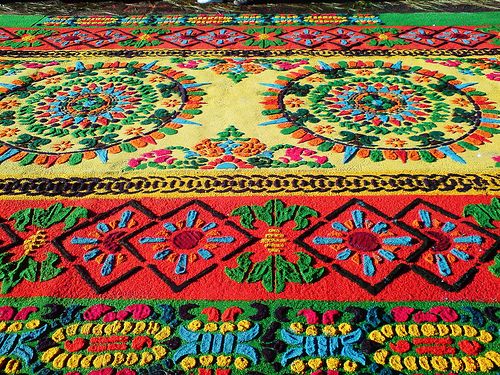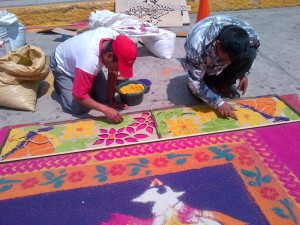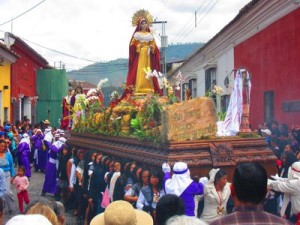When I lived in Honduras, the streets of the town would be decorated for Semana Santa, Holy Week. The long street up to the cathedral door was impossibly pocked with holes and rocks, and in the rainy season, normally sloshed with mud. But for Palm Sunday, it was transformed by the creation of alfombras or carpets that covered the offending roughness with beauty. The people in the neighborhood brought mango leaves, tamarind pods, pebbles, shells, fuschia, and other flowers that grew wild around the edges of the road. Sophisticated flowers and varieties of fruits and vegetables were bought in the market to be used and sawdust was dyed vibrant colors in preparation. Sometimes folks would work all night with their neighbors to finish their creations. There were wooden frames that helped to demarcate some of the designs, but most of them were free form, the sawdust sprinkled and cajoled into place and the flowers and leaves and fruits and veggies placed artistically in the intricate designs. The parade would line up at the end of the street. There were children and grannies walking and homemade, but elaborate floats decorated with figures of the characters and artifacts from the Holy Week stories: beaten and often bloodied Jesus, several disciples, various Marys, crosses, hammers, Roman soldiers, and an impressive group of mourners, all dressed in black, and all accompanied by sometimes oddly cheerful music offered by local people playing instruments and sometimes fading in and out from a battered boom box carried in the back of a truck. In about 5-8 minutes, the shuffling feet of the procession had marred the alfombras and clean-up crews jumped out of the crowds who watched along the road, and the whole thing disappeared.
It was long before the days of cell phones and no one had a camera. My friend used to sketch some of the designs in her journal, but mostly, we just remembered them and discussed new ideas for the next time. I felt inspired by how joyful and cooperative everyone seemed to be while working on the alfombras, and how peaceful they seemed to be when the parade was over. It felt immense and futile to me to create something so beautiful and then watch it disappear. The spiritual ability to let things go often eluded me then and eludes me now.
The creation of the alfombras in Latin America is an act of devotion that is similar in nature to the Sand Mandalas created by Buddhist monks. Though the destruction of those mandalas is very intentional with particular rituals and rubrics, and not simply trodden underfoot like the alfombras, still, the inherent teaching is the same. Hold on loosely. Life is beautiful and ephemeral. Show up. Pay attention. Be present to life in all of its mystery.



